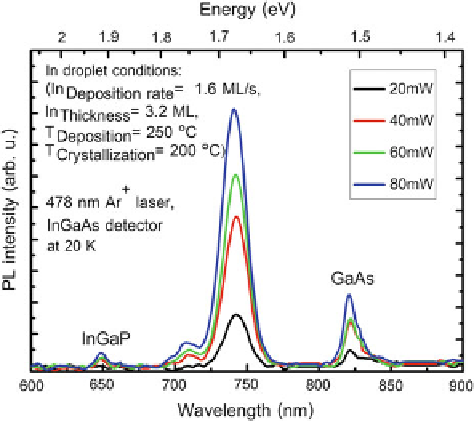Biomedical Engineering Reference
In-Depth Information
Fig. 2.16
Power dependence of PL emission from InP ring-shaped QDMs at 20 K
and crystallization temperatures are 250 and 200
◦
C, respectively, with indium
deposition rate of 1.6 ML/s and with indium thickness of 3.2 ML. Under these
optimized growth conditions, the best QD size uniformity and the percentage of
octa-QDMs as high as 46% can be maintained.
In order to understand the optical behavior of InP ring-shaped QDMs, further
experiment on photoluminescence is continued by changing the excitation power
and sample temperature. Figure
2.16
shows laser power dependence of PL emission
from InP ring-shaped QDMs. The main PL peak is originated from the ground state
having an emission wavelength of 740 nm, which is slightly blue-shifted at high
excited laser power. PL peaks have FWHM values of 40-45 meV reflecting the
uniformity of QDs on the rings. At high laser power, a weaker PL peak from the
first excited state is also detected at 710 nm. In the PL spectra, PL emissions from
InGaP and GaAs bulk materials are also observed at 650 and 850 nm, respectively.
When laser power excitation is fixed at 40 mW and sample temperature is varied
from 20 to 100 K, temperature dependence of PL from InP ring-shaped QDMs is
measured. The experimental result is shown in Fig.
2.17
.
At a high sample temperature, PL peaks are red-shifted and FWHMs are
broadened. PL signal is weakened due to thermal carrier escape from QDs to
In0.5Ga0.5P capping layer. Defects in MEE grown In0.5Ga0.5P would trap those
carriers leading to lower PL signal in a high temperature range.

